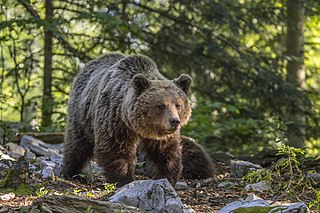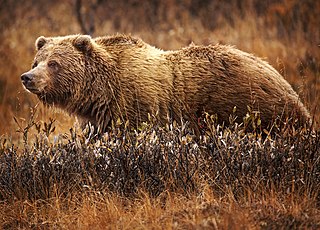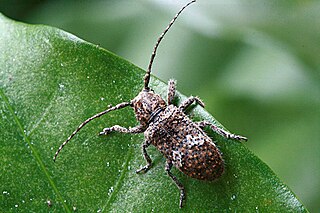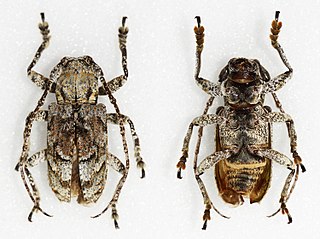
The brown bear is a large bear species found across Eurasia and North America. In North America, the populations of brown bears are called grizzly bears, while the subspecies that inhabits the Kodiak Islands of Alaska is known as the Kodiak bear. It is one of the largest living terrestrial members of the order Carnivora, rivaled in size only by its closest relative, the polar bear, which is much less variable in size and slightly bigger on average. The brown bear's range includes parts of Russia, Central Asia, the Himalayas, China, Canada, the United States, Hokkaido, Scandinavia, Finland, the Balkans, the Picos de Europa and the Carpathian region, Iran, Anatolia, and the Caucasus. The brown bear is recognized as a national and state animal in several European countries.

The California grizzly bear is an extinct population or subspecies of the brown bear, generally known as the grizzly bear. "Grizzly" could have meant "grizzled" – that is, with golden and grey tips of the hair – or "fear-inspiring". Nonetheless, after careful study, naturalist George Ord formally classified it in 1815 – not for its hair, but for its character – as Ursus horribilis. Genetically, North American brown bears are closely related; in size and coloring, the California grizzly bear was much like the Kodiak bear of the southern coast of Alaska. In California, it was particularly admired for its beauty, size, and strength. The grizzly became a symbol of the Bear Flag Republic, a moniker that was attached to the short-lived attempt by a group of U.S. settlers to break away from Mexico in 1846. Later, this rebel flag became the basis for the state flag of California, and then California was known as the "Bear State".

The Arctic wolf, also known as the white wolf or polar wolf, is a subspecies of grey wolf native to the High Arctic tundra of Canada's Queen Elizabeth Islands, from Melville Island to Ellesmere Island. Unlike some populations that move between tundra and forest regions, Arctic wolves spend their entire lives north of the northern treeline. Their distribution to south is limited to the northern fringes of the Middle Arctic tundra on the southern half of Prince of Wales and Somerset Islands. It is a medium-sized subspecies, distinguished from the northwestern wolf by its smaller size, its whiter colouration, its narrower braincase, and larger carnassials. Since 1930, there has been a progressive reduction in size in Arctic wolf skulls, which is likely the result of wolf-dog hybridization.

The Atlas bear or North African bear is an extinct population or populations of brown bear native to North Africa that became extinct in historical times.

The Tibetan brown bear or Tibetan blue bear is a subspecies of the brown bear in the eastern Tibetan Plateau.

The Eurasian brown bear is one of the most common subspecies of the brown bear, and is found in much of Eurasia. It is also called the European brown bear, common brown bear, common bear, and colloquially by many other names. The genetic diversity of present-day brown bears has been extensively studied over the years and appears to be geographically structured into five main clades based upon analysis of the mtDNA.

The Syrian brown bear is a relatively small subspecies of brown bear native to the Middle East and the Caucasus mountain range.

The Himalayan brown bear, also known as the Himalayan red bear, isabelline bear or Dzu-Teh, is a subspecies of the brown bear and is known from northern Afghanistan, northern Pakistan, northern India, west China and Nepal. It is the largest mammal in the region, males reaching up to 2.2 m (7 ft) long, while females are a little smaller. The bears are omnivorous and hibernate in dens during the winter. While the brown bear as a species is classified as Least Concern by the IUCN, this subspecies is critically endangered and populations are dwindling.

The grizzly bear, also known as the North American brown bear or simply grizzly, is a population or subspecies of the brown bear inhabiting North America.
Sphaerium beckmani is an extinct species of fossil freshwater pea clams from the Late Cretaceous deposits of North America. This species was first described by the American paleontologist Loris Shano Russell in 1976. The specimens were collected by the American paleontologist Karl M. Waage from 1961 to 1962 from the Hell Creek Formation of eastern Montana. The locality is dated to the late Maastrichtian Age.

The Alaska Peninsula brown bear or "peninsular grizzly" is a colloquial nomenclature for a brown bear that lives in the coastal regions of southern Alaska. It may be a population of the mainland grizzly bear subspecies.

Rhytiphora is a genus of flat-faced longhorn beetles in the Pteropliini tribe of the subfamily Lamiinae. The genus was first described in 1835 by Jean Guillaume Audinet-Serville.

Rhytiphora bankii is a species of beetle in the family Cerambycidae. It was first described by Johan Christian Fabricius in 1775, under the genus Lamia. It is known from Australia, the Philippines, Borneo, Java, Micronesia, New Guinea, Hawaii, Moluccas, Sumatra, Vietnam, and has been introduced into Japan. The Australian species of Prosoplus were synonymised with Rhytiphora in 2013.
Rhytiphora viridescens is a species of beetle in the family Cerambycidae. It was described by Stephan von Breuning in 1938. It is known from Australia.

Rhytiphora maculicornis is a species of beetle in the family Cerambycidae. It was described by Francis Polkinghorne Pascoe in 1858. It is from Australia.
Rhytiphora saundersi is a species of beetle in the family Cerambycidae. It was described by Francis Polkinghorne Pascoe in 1857. It is known from Australia. It contains the varietas Rhytiphora saundersi var. spenceri.
Rhytiphora argus is a species of beetle in the family Cerambycidae. It was described by Francis Polkinghorne Pascoe in 1867. It is known from Australia.
Rhytiphora sospitalis is a species of beetle in the family Cerambycidae. It was described by Francis Polkinghorne Pascoe in 1865. It is known from Australia.
Rhytiphora albocincta is a species of beetle in the family Cerambycidae. It was described by Félix Édouard Guérin-Méneville in 1831, originally under the genus Saperda. It is known from Australia. It feeds on Acacia pubescens and Acacia longifolia. It contains the variety Rhytiphora albocincta var. compos.
Formerly or currently considered subspecies or populations of brown bears have been listed as follows:












